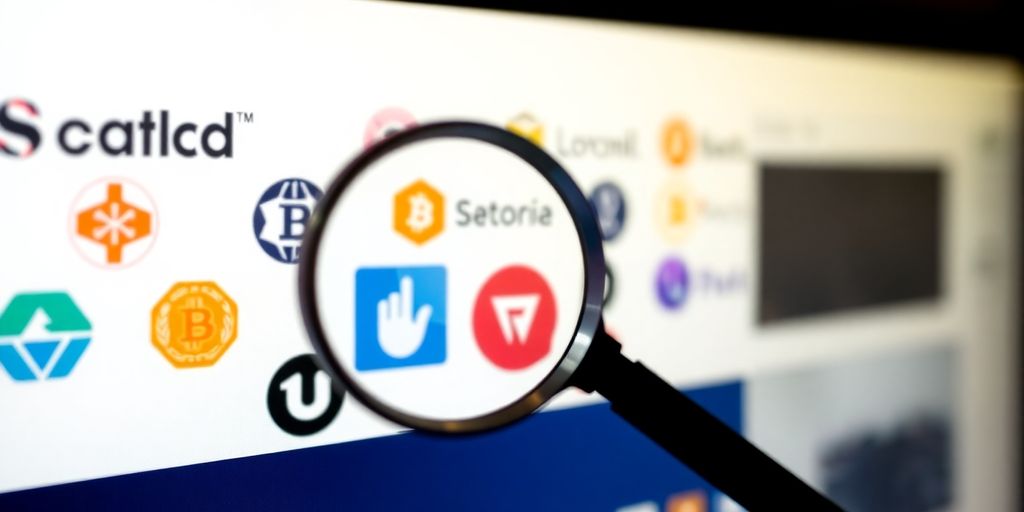In the fast-paced world of cryptocurrencies, knowing how to spot a trustworthy platform from a fraudulent one is crucial. With scams becoming increasingly common, it’s essential for both new and seasoned investors to understand the signs of real or fake crypto platforms. This guide will help you navigate through the murky waters of crypto exchanges so you can safeguard your investments and make informed decisions.
Key Takeaways
- Always look for transparency in operations and clear contact details.
- Be cautious of platforms promising unrealistically high returns on investments.
- Research the team behind the platform to verify their credentials and experience.
- Check for robust security features like two-factor authentication and encryption.
- Utilize online tools and community feedback to validate the legitimacy of a crypto platform.
Recognizing Common Characteristics Of Real Or Fake Crypto Platforms
Understanding Platform Transparency
When you’re checking out a crypto platform, transparency is super important. Real platforms are usually pretty open about how they work, who’s in charge, and where they’re located. If a platform is cagey about this stuff, it’s a red flag. They should have clear explanations of their fees, security measures, and how they handle your money. Think of it like this: if they’ve got nothing to hide, they’ll show you everything. If they’re hiding stuff, there’s probably a reason. You want to see detailed information, not vague promises. For example, legitimate platforms will provide clear information about its fee structure.
Evaluating User Reviews
User reviews can be a goldmine of information, but you’ve gotta take them with a grain of salt. Look for patterns. Are there a bunch of people saying the same thing, good or bad? That’s usually a sign that something’s really going on. Watch out for reviews that are super generic or overly enthusiastic – those could be fake. Also, check out different review sites and forums to get a well-rounded picture. Don’t just rely on the reviews on the platform’s own website, because those are probably cherry-picked. Here’s what to look for:
- Consistent complaints about withdrawals
- Reports of poor customer service
- Concerns about hidden fees
It’s important to remember that every platform will have some negative reviews. No one’s perfect. But if the negative reviews outweigh the positive ones, or if there are serious red flags in the reviews, it’s time to move on.
Checking Regulatory Compliance
Regulatory compliance is a big deal in the crypto world. Legitimate platforms will be registered with the appropriate regulatory bodies in their jurisdiction. This means they have to follow certain rules and regulations, which helps protect users. Look for information about their regulatory status on their website. If they’re not regulated, or if they’re regulated in some obscure jurisdiction that you’ve never heard of, that’s a warning sign. Regulations protect users by:
- Ensuring platforms have adequate security measures.
- Requiring platforms to have anti-money laundering (AML) policies.
- Providing a framework for resolving disputes.
Key Red Flags To Identify Fake Crypto Platforms
It’s super important to be able to spot a fake crypto platform before you lose any money. These platforms often use tricks to lure people in, so knowing what to look for can save you a lot of trouble. Being aware of these red flags is your first line of defense.
Unrealistic Promises Of Returns
If a platform is promising crazy high returns with little to no risk, that’s a major red flag. Crypto is volatile, and nothing is guaranteed. Be very skeptical of any platform that sounds too good to be true. It probably is. Scammers often use guaranteed returns to lure in unsuspecting investors.
Lack Of Contact Information
Real crypto platforms will have clear and easy-to-find contact information, including a physical address, phone number, and email. If a platform is hiding its contact details or only offers a contact form with no direct way to reach them, that’s a big warning sign. You should be able to easily get in touch with someone if you have questions or issues.
Poor Website Design
A legitimate crypto platform will invest in a professional and user-friendly website. If the website looks amateurish, has spelling errors, or is difficult to navigate, it could be a sign that it’s not a real platform. A poorly designed website shows a lack of professionalism and could indicate that the platform is not legitimate. Here are some things to look for:
- Broken links
- Low-quality images
- Grammatical errors
Always do your research and be cautious when dealing with new or unfamiliar crypto platforms. If something feels off, trust your gut and don’t invest. It’s better to be safe than sorry when it comes to your money. Due diligence is key.
Researching The Team Behind The Platform
It’s easy to get caught up in the hype around a new crypto platform, but taking a step back to investigate who’s actually running the show is super important. You wouldn’t invest your money with a complete stranger on the street, right? Same idea here. Knowing who’s behind the platform can give you a much better sense of its legitimacy and potential for long-term success.
Verifying Team Credentials
First things first, see if you can actually find the team. A legitimate platform will proudly display its team members, usually with names, titles, and maybe even a short bio. If the platform is hiding its team, that’s a major red flag. Once you’ve found some names, do some digging. Check out their LinkedIn profiles, look for any past work experience, and see if they have any relevant qualifications. Are they claiming to be experts in blockchain technology but have a background in, say, selling used cars? That might be a problem. You can also use tools like Crunchbase to see if they’ve worked on any other successful projects in the past. Don’t just take their word for it – verify, verify, verify. It’s also a good idea to check for user reviews to see what others are saying about the platform.
Checking Professional Backgrounds
Okay, so you’ve found the team, and they seem to have some relevant experience. Great! But don’t stop there. Dig a little deeper into their professional backgrounds. Have they worked for reputable companies in the past? Have they been involved in any previous crypto projects? A quick Google search can often reveal a lot about a person’s professional history. Look for any red flags, such as involvement in failed projects, accusations of fraud, or any other shady behavior. A solid track record is a good sign, while a history of questionable activities should give you pause.
Identifying Team Members
Sometimes, a platform will list team members, but it’s hard to tell if they’re real people or just stock photos with fake names. Try to find independent confirmation that these people actually exist and are associated with the platform. Look for interviews, articles, or social media posts that mention them in connection with the project. If you can’t find any independent verification, it’s possible that the team is using fake profiles to create a false sense of legitimacy. Also, pay attention to the roles and responsibilities of each team member. Does the team have a good mix of technical expertise, marketing skills, and business acumen? A well-rounded team is more likely to be successful than a team that’s lacking in key areas. Here are some things to look for:
- Do they have a presence on professional networking sites?
- Are they active in the crypto community?
- Can you find any independent verification of their claims?
It’s important to remember that even if the team seems legitimate, there’s still no guarantee that the platform will be successful. However, by doing your due diligence and researching the team behind the project, you can significantly reduce your risk of getting scammed. Remember to check for crypto exchanges that are well-known and established.
Evaluating Security Features Of Crypto Platforms

It’s really important to look closely at the security features a crypto platform offers. You’re trusting them with your money, after all! Let’s break down what to look for.
Importance Of Two-Factor Authentication
Two-factor authentication (2FA) is a must-have. Think of it as a second lock on your door. It means that even if someone gets your password, they still need a code from your phone or another device to get in. Most legit platforms offer this, but some shady ones don’t even bother. If a platform doesn’t have 2FA, that’s a big red flag.
Assessing Encryption Standards
Encryption is how platforms protect your data as it travels across the internet. Look for platforms that use strong encryption methods, like SSL/TLS. You can usually tell if a site is using SSL because the URL starts with “https” instead of “http”.
Understanding Withdrawal Policies
Take a good look at the platform’s withdrawal policies. How long do withdrawals take? Are there any fees? Are there any limits on how much you can withdraw? These policies can tell you a lot about how the platform operates. If withdrawals are super slow or there are weirdly high fees, that could be a sign that something isn’t right.
It’s a good idea to test out the withdrawal process with a small amount of crypto before you deposit a lot of money. This way, you can make sure that everything works as it should and that you’re comfortable with the process.
Analyzing User Experience And Customer Support
User experience (UX) and customer support are super important when picking a crypto platform. A good platform should be easy to use and offer help when you need it. If a platform is hard to use or doesn’t offer good support, it might be a sign to stay away.
Testing Response Times
How fast does the platform respond to questions? This is a big deal. Try contacting their support team through different channels (email, chat, phone if they have it) and see how long it takes to get a response. A slow response time can be a red flag, especially if you’re dealing with time-sensitive issues like transaction problems. Here’s a simple way to think about it:
- Immediate (under 5 minutes): Excellent
- Within 1 hour: Good
- Within 24 hours: Okay
- Longer than 24 hours: Not good
Evaluating Support Channels
What kind of support does the platform offer? Do they just have an email address, or do they also have live chat, a phone number, or a detailed FAQ section? The more options, the better. A platform that only offers email support might not be the best choice, especially if you need help right away. Also, check if they have tutorials or guides to help you understand how to use the platform.
Reading User Feedback
What are other users saying about their experience with the platform? Check out reviews on sites like Trustpilot, Reddit, or other crypto forums. Look for patterns in the feedback. Are people consistently complaining about the same issues, like slow withdrawals or poor customer service? If so, that’s a major red flag. Don’t just rely on the platform’s own website for reviews, as those can be biased.
It’s easy to get caught up in the hype around crypto, but taking the time to check out user reviews and test the customer support yourself can save you a lot of headaches down the road. A platform might look great on the surface, but if users are having bad experiences, it’s probably best to look elsewhere.
Understanding The Role Of Regulatory Bodies
It’s easy to get caught up in the excitement around crypto, but it’s super important to understand who’s watching over things. Regulatory bodies play a big role in keeping the crypto space safe and fair. They’re like the referees, making sure everyone plays by the rules. Without them, it’d be like the Wild West, and that’s not good for anyone.
Importance Of Compliance
Compliance is basically following the rules set by these regulatory bodies. It’s not just about avoiding fines; it’s about building trust. When a crypto platform complies with regulations, it shows they’re serious about protecting their users and operating legitimately. Think of it like this: if a store always follows health codes, you’re more likely to trust their food. Similarly, compliance in crypto builds confidence.
How Regulations Protect Users
Regulations are designed to protect users from scams, fraud, and other shady activities. They often require platforms to implement security measures, verify user identities, and maintain certain levels of transparency. For example, FinCEN’s guidance helps to ensure compliance and oversight. It’s like having a safety net – you hope you don’t need it, but it’s good to know it’s there. Regulations can also help to ensure that platforms have enough money to cover user funds, preventing situations where a platform goes bankrupt and users lose everything.
Identifying Regulated Platforms
Figuring out if a platform is regulated can take a little digging. Look for information on the platform’s website about their regulatory status. They should clearly state which regulatory bodies they’re registered with and provide relevant license numbers. If you can’t find this information, that’s a red flag. You can also check the websites of regulatory bodies themselves to see if a platform is listed. It’s a bit like checking if a contractor is licensed before hiring them – it’s worth the effort to make sure they’re legit. Always do your research before entrusting your money to any platform.
It’s important to remember that regulations vary from country to country. A platform that’s regulated in one jurisdiction might not be in another. So, make sure you understand the regulations that apply to you and the platform you’re using.
Utilizing Online Tools For Verification

In the fight against crypto scams, you don’t have to go it alone. Several online tools can help you determine if a platform is on the up-and-up. These tools can provide an extra layer of security, helping you make informed decisions before investing your hard-earned money. It’s all about doing your homework and using the resources available to you.
Using Scam Alert Websites
Scam alert websites are like community watchdogs for the crypto world. They collect and share information about known scams, fraudulent platforms, and other shady activities. Before you trust a platform, run its name and website through these sites. You might find that others have already reported it as a scam, saving you a lot of trouble. These sites often have user reviews and ratings, giving you a sense of the platform’s reputation. Think of it as checking reviews before you buy something online, but with potentially much higher stakes. You can search complaints received by the DFPI regarding various companies.
Checking Blockchain Records
One of the cool things about crypto is that transactions are recorded on the blockchain. This means you can often trace the flow of funds and see if a platform is actually doing what it claims. If a platform is promising high returns but can’t show you where the money is coming from, that’s a big red flag. Blockchain explorers allow you to view transaction histories, wallet balances, and other data, providing transparency that’s often lacking in traditional finance. It might sound technical, but there are plenty of user-friendly guides to help you get started.
Leveraging Community Feedback
The crypto community is usually pretty vocal about scams and bad actors. Forums, social media groups, and other online communities can be great sources of information. If you’re unsure about a platform, ask around and see if anyone else has experience with it. Be careful about taking everything you read at face value, but look for patterns and consistent complaints. A healthy dose of skepticism, combined with community insights, can go a long way in protecting you from scams.
It’s important to remember that no tool is foolproof. Scammers are constantly evolving their tactics, so you need to stay vigilant and use a combination of methods to protect yourself. Don’t rely solely on one website or forum; cross-reference information and always trust your gut.
Wrapping It Up
In the end, knowing how to spot real versus fake crypto platforms is super important. Scammers are always coming up with new tricks, so staying alert is key. Remember to look for those red flags like promises of crazy returns or pressure tactics. Always do your homework before diving in. Check reviews, verify team backgrounds, and make sure you’re on the right website. If something feels off, trust your gut. By being cautious and informed, you can protect your investments and enjoy the crypto world safely.
Frequently Asked Questions
How can I tell if a crypto platform is a scam?
You can spot a scam by looking out for red flags like promises of guaranteed returns, unsolicited messages, and poor website quality. Legitimate businesses will not ask for your private keys or communicate through social media.
What are some examples of fake crypto platforms?
Many fake crypto platforms pop up for a short time. They usually take your money and disappear, creating a new site to trick more people.
How many crypto scams are reported each year?
In 2023, there were over 69,000 complaints about cryptocurrency scams in the U.S. alone, and worldwide, scams brought in at least $4.6 billion.
What should I do if I think I’ve been scammed?
If you suspect you’ve been scammed, gather any evidence you have, report it to the authorities, and seek advice from legal experts on how to possibly recover your funds.
How can I protect myself from crypto scams?
To protect yourself, always research platforms before using them, be skeptical of high returns, and never share your private keys. Stick to well-known exchanges.
What role do regulatory bodies play in crypto?
Regulatory bodies help ensure that crypto platforms follow the law, which protects users. They can help you identify which platforms are legitimate.



